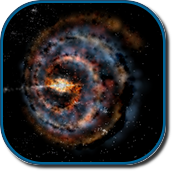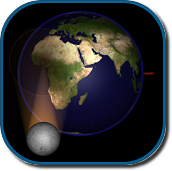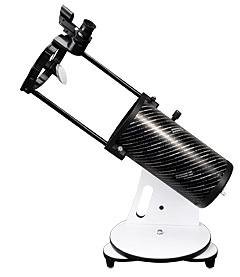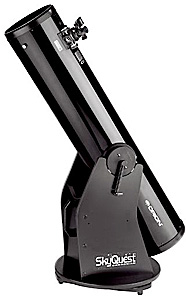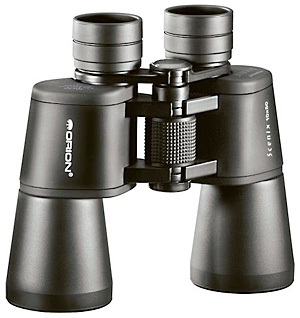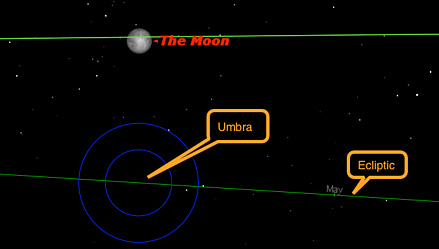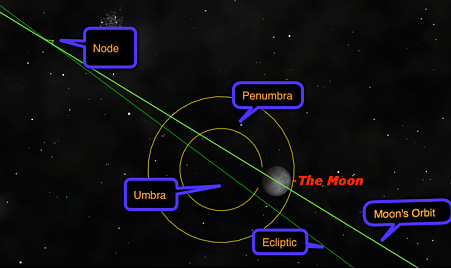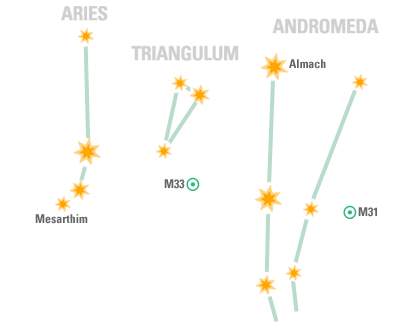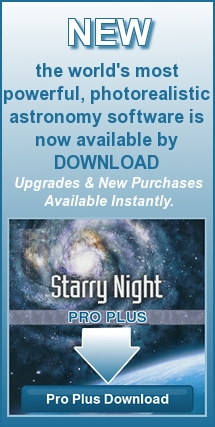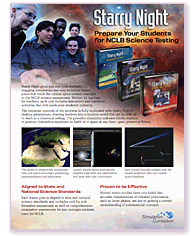 |
||||||||||||||||||||||||||||||||||||||||||||||||||||||||||||||||||||||||||||||||||||||||||||||||||||||||||||||||||||||||||||||||||||||||||||||||||||||||||||||||||||||||||||||||||||
For education orders please call 1-877-290-8256. Welcome again to our monthly newsletter with features on exciting celestial events, product reviews, tips & tricks, and a monthly sky calendar. We hope you enjoy it!
Starry Night 6.4 includes Particle Galaxies, 3D Shadow Cones, and Apollo Lunar Missions. Users of Starry Night Pro Plus, Pro, Enthusiast and Complete Space & Astronomy Pack can now update to version 6.4. Click below to read about the many enhancements and new data in this free update: To update your version of Starry Night, first make sure you are running the latest 6.3 update: Then in Starry Night select Check for Updates from the Help menu to automatically download the 6.4 update.
With the holiday gift season upon us, many people want to give something related to astronomy, either for a beginning astronomer or someone who is already a confirmed addict! Here are some ideas and suggestions. But first a word of warning. Astronomical instruments and accessories are very much a matter of personal taste, so it's wise to consult with the recipient before making a large financial commitment. Otherwise you risk disappointment, and a gift which will end up in a closet by New Year's. Most “serious” amateur astronomers agonize over exactly what purchases to make, and actually enjoy the process. Don't deprive them of their fun! Telescopes Be prepared to spend a bit of money to get a telescope which won't disappoint. Many of the telescopes you'll find on sale at this time of year at the mall are little more than kid's toys, and will almost certainly be a poor choice. Instead, do your shopping at a store which specializes in astronomy and telescopes. You will get good advice, good products, and invaluable after-sales service and support. If you have such a store locally, that should be the first place you go; otherwise you are better buying online from a well established dealer. Steer clear of Amazon and eBay, as there are many fly-by-night “dealers” touting very costly “bargains.” Traditionally a beginner's telescope has been a 60mm refractor or a 4.5-inch reflector—no one really knows why refractors are measured in millimeters and reflectors are measured in inches, but that's the tradition. In many respects, either of these is a very poor choice for two main reasons: their objectives (main lenses or mirrors) are too small and their mounts are too flimsy and hard to use. In recent years, there has been a rise of a new type of telescope called a “Dobsonian,” often called a “Dob” for short. They are named for their inventor, American monk John Dobson. This is (usually) a reflector mounted on a robust but solid mount with large bearings. Such telescopes require no alignment and are intuitive to use. There are two main commercial sources of beginner's Dobsonians: Orion and SkyWatcher. The telescopes from both are very similar in design and construction. Both companies sell small table-top Dobs and larger Dobs used on the ground. The table-top Dobs are the only inexpensive telescopes which I recommend. SkyWatcher makes them in 76mm (3-inch) and 130mm (5.1-inch) sizes; Orion in 76mm (3-inch), 100mm (3.9-inch), and 114mm (4.5-inch). These are all fairly limited in what they will show: the Moon, Venus' phases, Jupiter's moons, Saturn's rings, and a handful of bright deep sky objects, but still show more and are easier to use than the “traditional “ scopes mentioned above:
For a bit more money, you can get a larger Dobsonian from both these suppliers in apertures of 6-inches, 8-inches, 10-inches and beyond. These are truly versatile and satisfying instruments which will provide a lifetime of enjoyment: detailed views of the planets and hundreds of deep sky objects. This year for the first time, both manufacturers are offering motorized computerized “GoTo” versions of these popular scopes.
Alternatives to Telescopes Is a telescope necessarily the best gift for a budding astronomer? Perhaps not. Beginners often find themselves overwhelmed by the complexities of operating a telescope and, in particular, of locating interesting targets in the sky. In many ways a better way to get started in astronomy is with a good pair of binoculars and a good book or set of star maps. I own many different binoculars, but the ones I find myself using 99 times out of a hundred are the 10x50 size. These are small enough to be readily portable and easy to hand hold, yet have adequate magnification (10x) and aperture (50mm) to provide satisfying views of the night sky. Many different binoculars will serve, but one model that comes highly recommended is Orion's Scenix 10x50s:
The absolute best book for beginners in astronomy is NightWatch by Terence Dickinson (Firefly). This book has stood the test of time and has gone through four editions, each one better than the last. Beautifully written and lavishly illustrated, it gives the complete beginner everything they need to get started in the hobby of astronomy. Another great resource for a beginning astronomer is a good planetarium program like Starry Night. Unlike any book or chart, it provides a dynamic view of the night sky custom tailored to the user's location, date and time. Accessories Of course, the person you're gifting may already have a telescope, and this opens up a wealth of accessories to enhance their experiences. In previous December issues of Starry Night Times, I've given detailed lists of “stocking stuffers” from Orion's catalog, the “wish book” of every amateur astronomer, so I'll mention only a few of my favorites here. The number one accessory for me, as for most amateurs, is a new eyepiece. Most telescopes come supplied with one or two “plain vanilla” eyepieces, but the addition of a modern wide field or long eye relief eyepiece is like getting a whole new telescope. One trend in modern eyepieces is towards ever wider fields of view. Traditional eyepieces had views of 40 to 50 degrees, rather like looking through a drinking straw. Modern designs have gone from 65 degrees to 80 degrees to an eye-popping 100 degrees. The benefits are both aesthetic (putting objects in their larger context), practical (one eyepiece often does the work of two or three), and emotional (a wide field of view draws the viewer in, and gives them a “space-walk” experience). For many years Tele Vue has led the pack when it came to wide field designs, with their Panoptic (68°), Nagler (82°) and Ethos (100°) series, but now they have many competitors challenging them on quality and price. The other trend has been at the high magnification end of the eyepiece scale. High magnifications used to mean having to cram your eye against the eyepiece to see the field of view, risking getting eyelash oil on the lenses and freezing your eyeball. Again Tele Vue led the pack with their Radian series, all of which provide 20mm of eye relief, plenty for even eyeglass wearers to see the whole field of view. The result is an astonishing degree of observer comfort: using a high power eyepiece is now just as easy as using a low power. A comfortable relaxed observer just naturally sees more. Again, there are now less expensive competitors to Tele Vue, with Baader Hyperion and Orion Stratus leading the way. You can never have too many astronomy books. If they already have NightWatch, consider Terence Dickinson's other book, co-authored with Alan Dyer, The Backyard Astronomer's Guide (Firefly). Every astronomer needs a good star atlas, and the best is also the least expensive, Sky & Telescope's Pocket Sky Atlas by Roger W. Sinnott (Sky). Finally, consider a subscription to an astronomy magazine, such as Astronomy, Sky & Telescope, or SkyNews, or a membership in your local astronomy club or a national club like the Royal Astronomical Society of Canada. Clear skies and happy gifting! Geoff Gaherty
This year, Mother Nature is giving us a holiday present — a total eclipse of the Moon during the night of December 20 - 21. This ends an almost 3 year wait. North America hasn't seen a total lunar eclipse since February 2008. In order for a lunar eclipse to occur, the Moon must pass through the Earth's shadow. This can only happen when the Moon and Sun are on opposite sides of the Earth (at Full Moon.)
It seems then, that we should see a lunar eclipse every Full Moon. This would be true if the Moon's orbit was in the same plane as the Earth's orbit around the Sun (the ecliptic plane). Because its orbit is tilted by about 5 degrees, the Moon can be as much as 5 degrees above or below the center of the Earth's shadow which travels along the ecliptic. As the graphic below shows, on November 21, 2010, the Full Moon was about three degrees above the ecliptic.
To be near the ecliptic and hence the Earth's shadow, the Moon must be close to one of the two points where its orbit and the ecliptic intersect. These points are called nodes and are shown by a wedge-like symbol in Starry Night.
Starry Night 6.4 includes 3D Shadow Cones, umbra and penumbra. See it in action! As illustrated by Starry Night, on December 21 the Full Moon is close enough to one of the nodes that it can enter the Earth's shadow and produce a total or umbral lunar eclipse. The Moon will return to the same place in its orbit relative to the stars in 27.3 days (the sidereal month). Because the nodes of the Moon's orbit are precessing westward, the same position relative to the nodes is reached in 27.2 days (the draconic month). In any case, this is well over 2 days before Full Moon occurs again (the synodic month) and hence no lunar eclipse is possible in January of next year. For all bodies to return to the same relative position requires a bit less than a year (close to a draconic year), so we would expect another lunar eclipse in early December of 2011. Indeed, there is a total eclipse of the Moon December 10, 2011. Further Study Why is there a total lunar eclipse in June of 2011, only half a year after this December's eclipse? Answer to last month's question: The perigee of the Moon's orbit precesses eastward and thus it takes a bit longer for the Moon to catch up to it. Herb Koller
Planets Mercury will have seven apparitions in 2011. The table shows which apparitions will be good or bad in the Northern and Southern Hemispheres:
Venus will be a “morning star” for the first half of the year, reaching superior conjunction with the Sun on August 16, becoming an “evening star” the rest of the year. It is at greatest elongation west on January 7. The outer planets will reach opposition on the following dates during the year:
Mars will be far from the Earth all year. Solar Eclipses There will be four partial eclipses in 2011, but no total eclipses. Dates and visibility of the partial solar eclipses are as follows:
Lunar Eclipses There will be two total lunar eclipses, with visibility as shown below:
Geoff Gaherty
Great Walls of the Universe The universe contains hundreds of millions of galaxies. These galaxies clump together, to form super clusters. Super clusters in turn come together to form a number of massive walls of galaxies separated by vast voids of empty space. Pedro Braganca
Triangulum is well placed at this time of year for observations of M33, a spiral galaxy. However, at 2.4 million light years and only 5% as massive as our own galaxy, it's a dim fuzzy object in 8" scopes and requires good dark skies to show any detail. Follow a line from M33 through Mirach in Andromeda to find the brightest spiral in the sky, M31, the Andromeda Galaxy as well as its satellite galaxies M32 and M110. As with M33, the photons from M31 have traveled 2.4 million years to pass through the pupil of your eye and end their journey on your retina. The Andromeda Galaxy is also one of the few galaxies that's blue-shifted, meaning that is traveling toward us: almost all others are red-shifted and speeding away. Once you've found M31 with the aided eye, you can practice picking it out with the naked eye. You can then congratulate yourself that no-one can see any farther than you–the barely visible faint smudge you can just make out is the farthest object visible to the unaided eye. At the tip of the constellation's brightest limb, is Almach (Gamma Andromedae) a very sweet orange/blue double. And finally, below Triangulum, in Aries, is Mesarthim (Gamma Aries) another lovely double, orange/green, sitting 207 light years away with an angular separation of 7.5". Sean O'Dwyer
|
DEC 2010
|
|||||||||||||||||||||||||||||||||||||||||||||||||||||||||||||||||||||||||||||||||||||||||||||||||||||||||||||||||||||||||||||||||||||||||||||||||||||||||||||||||||||||||||||||||||

|
||||||||||||||||||||||||||||||||||||||||||||||||||||||||||||||||||||||||||||||||||||||||||||||||||||||||||||||||||||||||||||||||||||||||||||||||||||||||||||||||||||||||||||||||||||
|
||||||||||||||||||||||||||||||||||||||||||||||||||||||||||||||||||||||||||||||||||||||||||||||||||||||||||||||||||||||||||||||||||||||||||||||||||||||||||||||||||||||||||||||||||||
